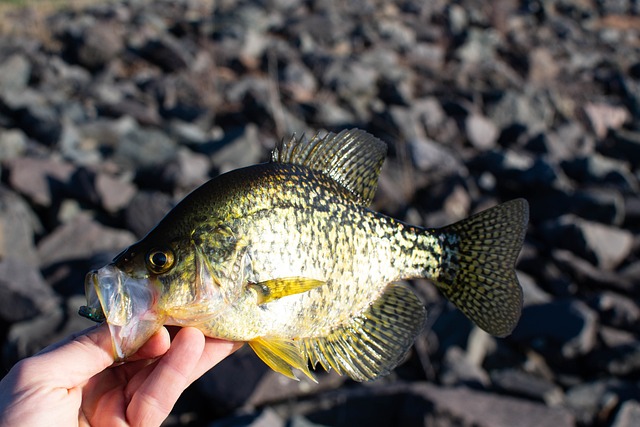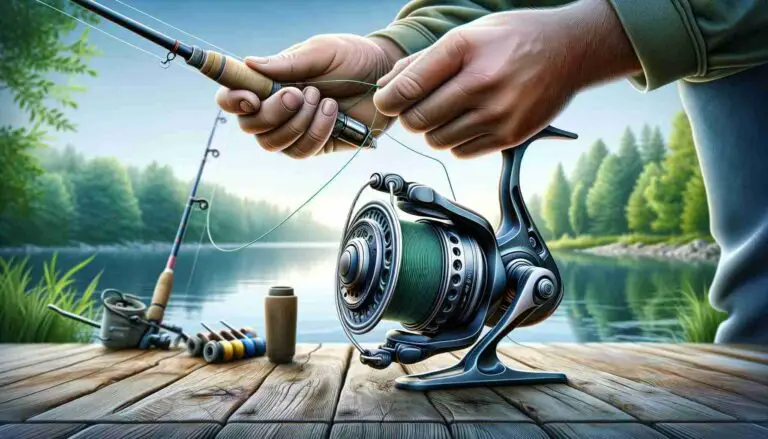Have you ever found yourself staring in awe at the stunning color variations of crappie? From vibrant shades of silver and gold to the captivating ebony black, these fish truly know how to catch our attention. But have you ever wondered why crappie turn black?
Crappie turn black primarily due to the distribution and concentration of melanin, the pigment responsible for dark colors. Factors such as genetics, environment, diet, health, and stress influence melanin production and distribution in crappie. Black coloration provides effective camouflage in murky waters, enhancing their hunting abilities.
Crappie, those beloved sport fish, come in different species and exhibit a wide range of colors. Their natural hues can leave us spellbound, but the black crappie, in particular, stands out with its distinctive ebony appearance. So, what’s the story behind this color shift? Today, I’m going to explore the various factors that influence the coloration of crappie, shedding light on this intriguing phenomenon.
I’ll delve into the life cycle of crappie, examine the environmental elements at play, uncover the role of diet, and even explore the impact of health and stress on their color changes. By the end, you’ll have a comprehensive understanding of why crappie turn black and how different factors contribute to their mesmerizing transformations.
Let’s get to it!
Understanding Crappie: A Colorful Fish
Before I dive into the specifics of why crappie turn black, let’s take a moment to appreciate the vibrant palette of colors that these fish display. Crappie are widely known for their remarkable color variations, making them a favorite among anglers and nature enthusiasts alike.
Crappie, scientifically known as Pomoxis, belong to the sunfish family and are native to North America. They come in two main species: the black crappie (Pomoxis nigromaculatus) and the white crappie (Pomoxis annularis). Each species has its own unique coloration, adding to their allure.
The black crappie is often admired for its striking appearance. Its body showcases a deep, dark coloration, ranging from shades of slate gray to almost jet black. This coloration serves as excellent camouflage in murky waters, allowing the fish to blend seamlessly with its surroundings.
On the other hand, the white crappie displays a lighter color palette. Its body is typically silvery or light gray, adorned with vertical bars or spots along its sides. These markings provide effective camouflage in clear waters, helping the white crappie navigate its environment and evade predators.
Both species of crappie possess a mesmerizing iridescent quality. When light hits their scales just right, they can shimmer with hints of green, blue, or purple. It’s like witnessing a living work of art gliding through the water.
Interestingly, even within each species, individual crappie can exhibit slight variations in coloration. Factors such as genetics, environment, and diet play a crucial role in these subtle differences, making each crappie unique in its own way.
Now that you have a better understanding of the colorful nature of crappie, let’s unravel the mystery of why some of them turn black.
The Life Cycle of Crappie
To understand why crappie turn black, it’s essential to explore their life cycle and the various stages they go through. The life cycle of crappie encompasses spawning, fry, juvenile, and adult stages, each playing a role in their coloration. So, let’s dive into these stages and uncover their significance.
- Spawning: The crappie spawning season usually occurs in spring when water temperatures reach around 55 to 60 degrees Fahrenheit (12 to 15 degrees Celsius). During this time, crappie gather in shallow areas, such as submerged vegetation or brush piles, to lay their eggs. The spawning process is a critical period that influences coloration changes in crappie.
- Fry: Once the eggs hatch, crappie enter the fry stage. Fry are small, transparent, and highly vulnerable to predators. At this stage, their coloration is generally minimal, and they often appear translucent or light in color.
- Juvenile: As the fry grow and develop, they transition into the juvenile stage. During this period, their coloration starts becoming more pronounced, and they begin to exhibit the distinct patterns of their species. Juvenile crappie may display a combination of silver, gray, or light brown hues, with markings such as bars or spots starting to emerge.
- Adult: As crappie mature into adults, their coloration becomes more prominent and defined. The black crappie, in particular, undergoes a remarkable transformation, displaying a darker, almost black coloration that gives them their name. The black coloration serves as an effective camouflage in darker, murky waters, allowing them to blend seamlessly with their surroundings and enhance their hunting prowess.
Genetics also play a role in determining the color patterns of crappie. Some individuals may exhibit more vibrant colors, while others might have a slightly duller appearance. These genetic variations, combined with environmental factors, contribute to the diverse array of colors observed in crappie populations.
Understanding the life cycle of crappie and how their coloration evolves throughout each stage provides valuable insights into why crappie turn black. But there’s more to the story. Join me as I explore the environmental factors that influence crappie color changes and uncover the secrets behind their mesmerizing transformations.
Environmental Factors Influencing Crappie Coloration
When it comes to the coloration of crappie, environmental factors play a significant role in shaping their appearance. Let’s explore some of the key environmental factors that influence crappie color changes.
- Water Clarity: The clarity of the water in which crappie reside can greatly impact their coloration. In clear waters with excellent visibility, crappie tend to exhibit lighter coloration, such as silvery or light gray hues. This lighter coloration helps them blend in and avoid detection by predators or prey. On the other hand, in murky or stained waters with reduced visibility, crappie are more likely to turn darker, including shades of black. This darker coloration provides them with effective camouflage, allowing them to ambush unsuspecting prey.
- Light Availability: The amount of light available in their habitat also affects crappie pigmentation. Adequate sunlight exposure stimulates the production of melanin, the pigment responsible for dark coloration. In areas with ample sunlight penetration, crappie may develop more intense and pronounced black coloration. Conversely, in habitats with limited light penetration, such as densely shaded areas or deep waters, crappie may exhibit lighter coloration.
- Habitat and Water Temperature: The specific habitat and water temperature in which crappie reside can influence their color changes. Crappie living in different habitats, such as lakes, ponds, or rivers, may display variations in coloration based on the characteristics of their environment. Additionally, water temperature fluctuations can impact crappie pigmentation. Warmer water temperatures often stimulate increased metabolic activity, leading to more vibrant coloration, whereas cooler temperatures may result in slightly duller colors.
It’s important to note that these environmental factors don’t act independently. Instead, they interact and influence each other, creating a complex web of factors that contribute to crappie color changes. The interplay between water clarity, light availability, habitat characteristics, and water temperature creates a dynamic environment that shapes the visual appearance of crappie.
Now that you’ve explored the influence of the environment on crappie coloration, let’s dive deeper into the intriguing relationship between their diet and pigmentation.
Diet and Crappie Color Transformation
When it comes to understanding why crappie turn black, their diet plays a crucial role in their color transformation. The food they consume not only nourishes them but also contributes to the pigmentation changes they undergo. So, let’s explore the fascinating relationship between diet and crappie coloration.
Crappie are opportunistic predators that feed on a variety of prey, including small fish, insects, crustaceans, and zooplankton. The pigments present in their prey can have an impact on crappie coloration. For instance, if crappie consume a diet rich in organisms containing pigments like carotenoids, which are often found in algae or certain invertebrates, it can lead to more vibrant coloration. Carotenoids can enhance the yellow, orange, or red hues in their scales, adding a touch of brightness to their appearance.
The consumption of certain foods can also influence melanin production in crappie. Melanin is the pigment responsible for dark colors like black. By consuming prey with high levels of melanin or melanin precursors, crappie can increase the production and distribution of melanin in their bodies, resulting in a darker coloration. This is one of the factors contributing to the black coloration observed in some crappie populations.
The availability of different prey species in their environment can also influence crappie color changes. When crappie have access to a diverse diet with a wide range of prey, they can exhibit a broader spectrum of colors. On the other hand, if their diet is limited to specific prey species, it can influence their coloration accordingly. For example, a diet primarily composed of small fish might contribute to a darker coloration in crappie.
It’s important to note that while diet plays a role in crappie color transformation, it is not the sole factor. Other elements, such as genetics, environment, and overall health, also interact to shape their pigmentation. The intricate interplay between these factors is what makes crappie coloration so fascinating and unique to each individual.
Let’s delve into the impact of health and stress on their pigmentation.
Health and Stress Factors
The health and well-being of crappie can significantly impact their coloration. Just like in humans, stress and certain health factors can manifest in visible ways, including changes in pigmentation. Let’s delve into the relationship between crappie coloration and their health and stress levels.
Crappie, like all living organisms, can experience stress. Factors such as overcrowding, poor water quality, sudden environmental changes, or predatory threats can induce stress in crappie. When under stress, crappie may exhibit color changes, including a darker or more intense pigmentation. This response is often attributed to the release of stress hormones, which can affect the distribution and production of melanin, leading to alterations in their coloration.
Crappie that are in good overall health tend to display more vibrant and attractive colors. Healthy crappie have a well-balanced diet, access to clean water, and are free from diseases or parasites. When crappie are in optimal health, their coloration can be more pronounced and visually appealing.
Conversely, if crappie are experiencing health issues or battling parasites, it can affect their pigmentation. Poor health can result in a duller or faded appearance, as the energy needed for vibrant coloration may be diverted towards healing or combating the underlying health problems.
It’s important to note that stress and health factors can have both short-term and long-term effects on crappie coloration. Temporary stressors may lead to temporary changes, while chronic stress or persistent health issues can cause longer-lasting alterations in their pigmentation.
Understanding the relationship between crappie coloration and their health and stress levels helps us appreciate the role these factors play in shaping their appearance.
Melanin and the Black Crappie
To understand why some crappie turn black, we must explore the role of melanin, the pigment responsible for dark coloration. Melanin is produced by specialized cells called melanocytes, and its distribution throughout an organism’s body determines its color.
In the case of black crappie, their deep black coloration is attributed to the higher concentration and distribution of melanin in their scales and skin. The melanin pigment absorbs light rather than reflecting it, resulting in the dark appearance.
Melanin production is influenced by various factors, including genetics, environmental conditions, and diet. Genetics play a significant role in determining the baseline melanin content in crappie. Certain individuals may have a genetic predisposition to produce and distribute more melanin, leading to a darker coloration.
Environmental factors, such as water clarity and light availability, can also influence melanin production. Crappie in habitats with low light conditions or murky waters tend to have higher melanin content. The darkness of their surroundings prompts their bodies to produce more melanin as a form of camouflage.
Additionally, the diet of crappie can impact melanin production and contribute to their black coloration. Consuming prey rich in melanin or melanin precursors can enhance the production and distribution of melanin in their bodies, intensifying their dark coloration.
It’s important to note that while black crappie are known for their deep black color, not all crappie turn black. White crappie, for example, typically exhibit lighter coloration with silver or gray hues, although they may also have some melanin distribution.
Understanding the role of melanin and its interaction with genetics, environment, and diet helps shed light on why some crappie turn black. It’s a fascinating process that showcases the intricate relationship between pigmentation and the natural world.
Other Color Variations in Crappie
Crappie, with their incredible array of color variations, offer a captivating visual spectacle for anglers and nature enthusiasts. While the black crappie stands out with its deep black coloration, there are other intriguing color variations that can be observed within crappie populations. Let’s explore some of these fascinating color variations in crappie.
- White Crappie: The white crappie (Pomoxis annularis) is a close relative of the black crappie but exhibits a distinct color pattern. Instead of the dark black coloration, white crappie typically display a lighter background color ranging from silver to light gray. They feature vertical bars or blotches on their sides, which can vary in intensity and pattern. These markings provide effective camouflage in their habitat, allowing them to blend in with aquatic vegetation or structure.
- Albinism: Albinism is a genetic condition that affects pigmentation in animals, including crappie. Albino crappie lack melanin, the pigment responsible for dark colors, resulting in a complete absence of pigmentation. As a result, their scales and eyes appear pale or pinkish, and they often have red or pink eyes due to the blood vessels showing through. Albino crappie are rare and can be visually striking, standing out from their counterparts due to their unique lack of color.
- Hybrid Variations: Crappie can also hybridize, resulting in unique color variations. Hybrid crappie can exhibit a combination of color traits from their parent species. For example, a hybrid between black and white crappie may display characteristics like a mixed coloration pattern, combining elements of both species. These hybrids can exhibit a fascinating blend of colors, making them visually distinct and appealing to anglers.
The presence of these color variations adds to the charm and allure of crappie. They highlight the remarkable diversity within crappie populations and demonstrate the complex interplay of genetics and environmental factors in shaping their appearance.
Conclusion
In conclusion, the question of why crappie turn black has been unraveled, revealing a tapestry of factors that contribute to their stunning color transformation. From genetics to environmental influences, diet, and even stress, each element plays a role in shaping the captivating black hue of some crappie. Whether it’s melanin production, the need for camouflage, or the interplay of various environmental factors, you now have a deeper understanding of the mysteries behind their coloration.
So, the next time you encounter a black crappie, you can appreciate the intricate balance of nature that gives rise to its striking appearance.
Happy fishing and may you continue to explore the captivating world of crappie!








